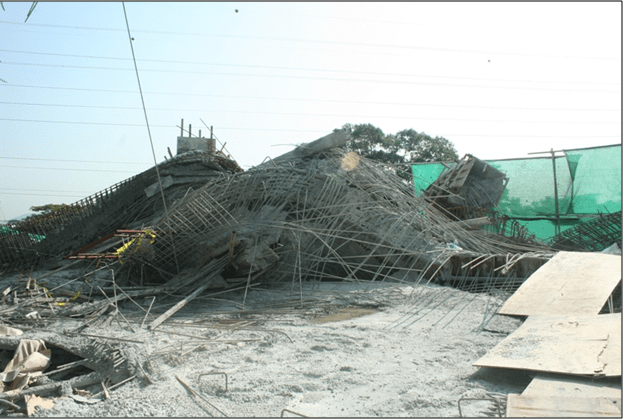Falsework Collapsed Case

A falsework collapsed during concreting works in construction site in Petaling Jaya. The accident causing 1 worker died and 5 others injured. Cause of the accident was the structure not capable to bear the applied load. Lack of co-ordination between the contractors, engineers and suppliers of falsework and erectors lack of understanding on structural shoring details and requirements maybe the underlying cause of the accident.
Falsework is any temporary structure used to support a permanent structure while it is not self-supporting, either in new construction or refurbishment. Any failure of falsework may lead to the collapse of the permanent structure. This could cause injury or death to those working on or near to it, as well as loss of time and money. The causes of failures could have been prevented by proper consideration when planning, erecting, loading or dismantling the falsework. On sites where there is a main contractor and a number of contractors, the main contractor is responsible for the safe co-ordination of all activities on-site (including liaison with specialist or suppliers). Main contractor’s responsibilities are:-
- ensuring the falsework is sound and stable;
- ensuring that those constructing and dismantling it can carry out their work safely, with particular regard to preventing falls from height; and
- minimizing risks to the health and safety of others who may be working on, or passing by, the construction activity. Risks could arise, for example, from falling materials, wind-blown plywood or scaffold boards, noise and dust.
Regulations and Standards
The law requires formwork and reshores shall be certified structurally safe by a Professional Engineer and shall be properly braced or tied together so as to maintain position and shapeas required byregulation 28(1) of the Factories And Machinery (Building Operations And Works Of Engineering Construction) (Safety) Regulations 1986 (BOWEC). A designated person should be appointed for each site as a falsework co-ordinator, with responsibility for co-ordinating the various items and stages of use of the falsework. The designated person must:
- ensure that correct falsework procedures are followed and that operations are carried out safely. Falsework should be constructed in accordance with BOWEC 1986 and BS 5975 Code of practice for falsework (and subsequently to BS EN 12812, when it is published) or other relevant standards.
- suitably technical person who has structural engineering knowledge.
- concern towards the preparation of a design brief, which should serve as the starting point for subsequent decisions, design work, calculations and drawings. Initial planning should cover what needs to be supported, and how it should be done and how long the falsework will be in use.
Design
All falsework should be designed. This will vary from the use of simple standard solution tables and graphs, to site-specific design and supporting drawings. Designs should be checked. Falsework engineers, including those designing formwork and shoring must:
- identify the hazards;
- eliminate the hazards, if feasible;
- reduce the risk by design; and
- provide the information necessary to identify and manage the remaining risks.
Particular consideration should be given to the following:
- stability requirements, lateral restraint and wind uplift on untied decking components;
- designing falsework that can be erected, inspected and dismantled safely including how striking will be achieved (it may be craned into position in one piece but could have to be removed piecemeal);
- selecting adequate suppots/foundations or providing information to ensure adequate supports/foundations are used; and
- providing the information that the designated person will need to manage the interface between the falsework and the permanent structure safely.
Erecting the falsework
Falsework should be constructed, strong enough and stable in use, so as to be suitable for the purpose for which it is used. It should be checked regularly. Components used in falsework must be concerned where:
- damaged components should not be used; and
- different proprietary components should not be mixed, unless expressly approved by the designer.
Before erection begins a HIRARC should be carried out and a safe system of work which includes how all the hazards are to be managed should be prepared. This should be read and understood by those doing the work. To ensure safety, falsework should be stable at all stages of erection and be regularly checked. Once complete, all falsework should be inspected and certified as ready for use (a written permit-to-work procedure is strongly recommended). The frequency of subsequent inspections will depend on the nature of the falsework. They should be carried out frequently enough to enable any faults to be rectified promptly.
Striking and dismantling
The designated person should agree the time of striking for each section of the falsework. During dismantling, ensure that workers can work safely and cannot be injured by falling objects. A sequence for dismantling should be agreed and detailed. Designated person, and those erecting and dismantling falsework, should be competent and trained in the safety of falsework.
References
- Factories and Machinery (Building Operations And Works Of Engineering Construction) (Safety) Regulations 1986 (BOWEC)
- Construction (Design and Management) Regulations 1994, as amended (CDM)















